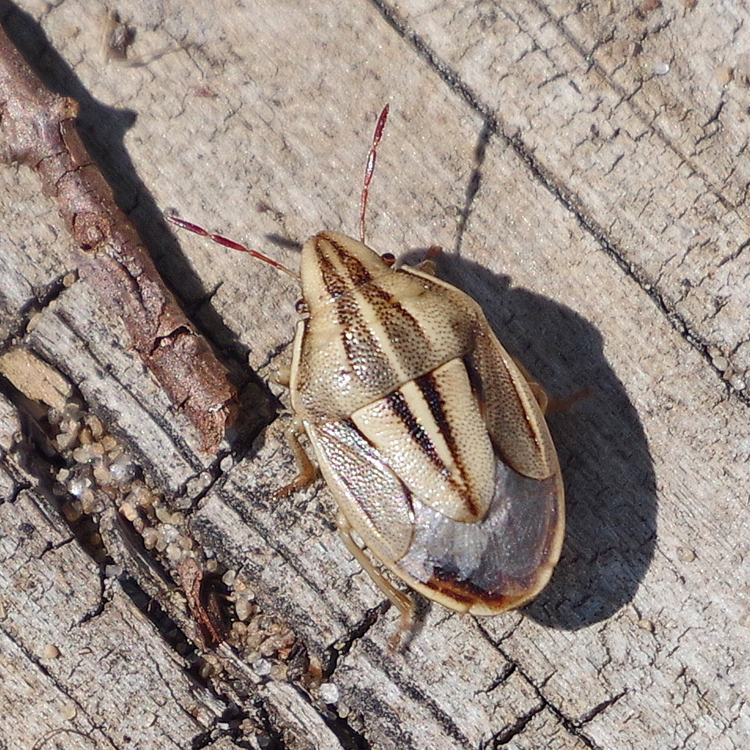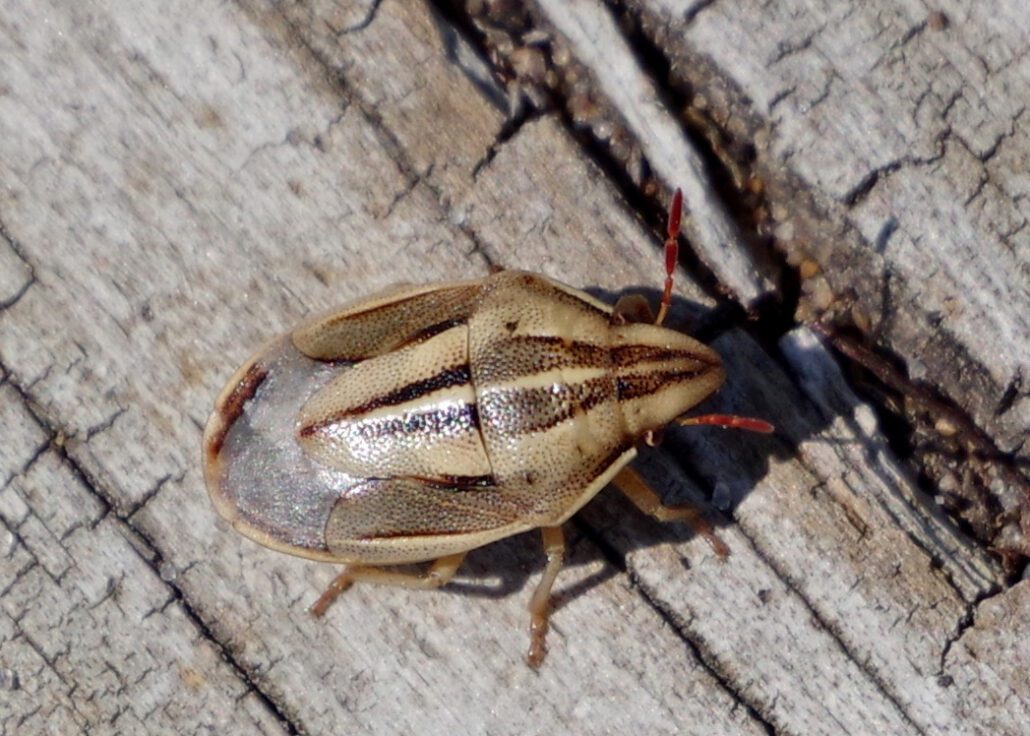
by Kate Redmond
Cereal bug
Greetings, BugFans,
The BugLady loves finding an insect she’s never seen before. When she saw it walking along a cordwalk (boardwalk on sand) in the dunes at Kohler-Andrae State Park, she knew that this guy/gal was in the stink bug family (Pentatomidae), but it’s more spindle-shaped and lacks the “shoulder pads” of a generic stink bug https://bugguide.net/node/view/2125170/bgpage (younger BugFans may have to Google “shoulder pads”).
It turned out to be a stink bug in the large subfamily Pentatominae and in the very small tribe Aeliini, which has only 37 species worldwide. There are 8 species in the tribe in North America (in two genera), and this is the only species in its genus here. The BugLady borrowed the name “Cereal bug” from one of the European species because she couldn’t find a common name for it.
Cereal bugs (Aelia americana) have an odd, patchwork range (based on pictures submitted by bugguide members https://bugguide.net/node/view/668478/data) that lies mostly west of the Mississippi – from British Columbia to Arizona to Alabama to Michigan, and within their range, they’re not very common.

They feed by day on the ripening seeds of grasses, including agricultural crops like wheat, barley, and rye (https://bugguide.net/node/view/2241245/bgimage). The BugLady found some brief write-ups about them from grain-producing areas of the upper Great Plains into Canada, but they’re not common enough to be a nuisance here. Like other Hemipterans, they insert their beak into the plant, pump in some digestive juices, and suck out the softened tissue.
Eggs are laid in late spring and early summer, and the nymphs reach maturity by fall and overwinter as adults.
[In the “Eternal Job Security” category that is insect taxonomy, the BugLady found a paper titled “Opening Pandora’s box: molecular phylogeny of the stink bugs (Hemiptera: Heteroptera: Pentatomidae) reveals great incongruences in the current classification.” It reminded her of a quote she found years ago when she was writing about a moth, “The genus Haploa …… has furnished a great deal of amusement to classificationists.” Presumably, the Hemiptera taxonomists are similarly amused.]
Along with grasses, they have been collected from apple trees in orchards, and according to a paper published by the Michigan Entomological Society, adults have been found overwintering in grass clumps and under mullein leaves.
Some genus members are considered pests in the Middle East and around the Mediterranean, though, and the BugLady found a lot more information about a closely-related-and-very-similar-looking European species called (wonderfully) the Bishop’s mitre (Aelia acuminata) than she did about our domestic species, but she suspects that the two are up to some of the same tricks.
The Bishop’s mitre (a mitre/miter is a bishop’s peaked, ceremonial hat) is found feeding on grasses in dry meadows and damaging cereal crops across Europe, North Africa, and northern Asia, and the britishbugs.org website added that they may be found in sand dunes, too. One British site said that the bugs resemble a grass seed (https://www.britishbugs.org.uk/heteroptera/Pentatomidae/aelia_acuminata.html). They winter in grain fields, in leaf litter and other sheltered spots, and they migrate to wheat fields in spring when the wheat shoots appear (they’re good flyers). Before the seeds are formed, they feed on juices from the stems of young plants. After harvest, they move to wild grasses.
Studies have shown that they enter diapause/dormancy/developmental arrest when the weather gets too hot in summer and go into hibernation when the weather gets too cold in fall. The increasing day lengths of spring stimulate egg-laying, but if there’s a cold snap, females will stop ovipositing.
Aelia americana was named by a British entomologist named William Sweetland (W.S.) Dallas (1824 – 1890). He published a book in 1857 called Elements of Entomology: An Outline of the Natural History and Classification of British Insects which is still in print today and about which the folks at Amazon say “This book is an essential resource for amateur and professional entomologists alike. This work has been selected by scholars as being culturally important, and is part of the knowledge base of civilization as we know it.”
Kate Redmond, The BugLady
Bug of the Week archives:
http://uwm.edu/field-station/category/bug-of-the-week/
